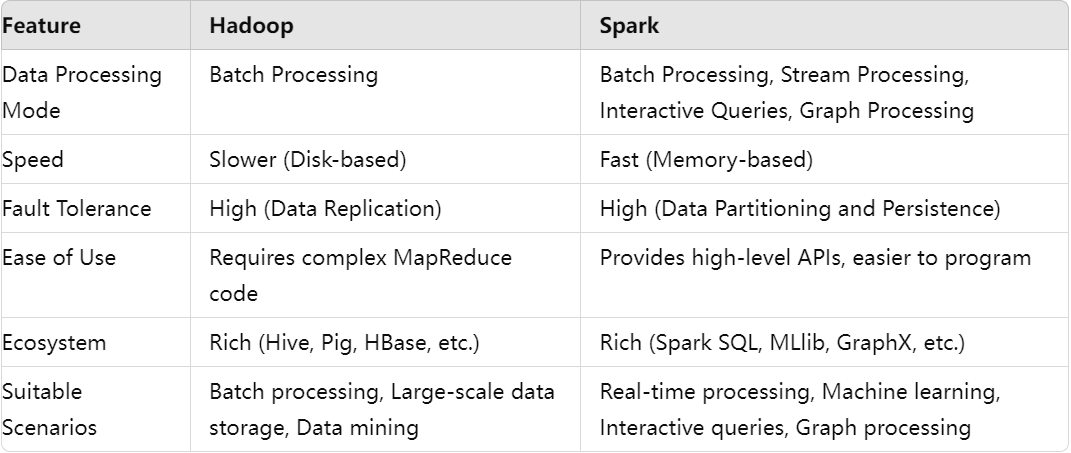Hadoop与Spark的比较与应用
Comparison and Application of Hadoop and Spark
作者:邵卿轩
Author: Shao Qingxuan
在大数据处理领域,Hadoop和Spark是两个广泛使用的框架,各自有其独特的特点和应用场景。本文将对Hadoop和Spark进行比较,并探讨它们在不同应用中的优势。
In the field of big data processing, Hadoop and Spark are two widely used frameworks, each with its unique characteristics and application
scenarios. In this paper, we will compare Hadoop and Spark and discuss their advantages in different applications.
1. Hadoop Introduction
Hadoop是一个Apache基金会开发的开源分布式计算框架,主要由两个核心组件组成:HDFS(Hadoop Distributed File System)和MapReduce。HDFS用于存储大规模数据集,而MapReduce则提供了一种编程模型,适用于处理这些数据。
Hadoop的主要特性:
1.1 分布式存储:HDFS能够将数据分块存储在多个节点上,提供高吞吐量的数据访问。
1.2 容错性:通过数据复制机制,HDFS确保了在硬件故障时数据的可靠性。
1.3 扩展性:Hadoop可以横向扩展,通过增加更多的节点来处理更大规模的数据。
1.4 生态系统:Hadoop拥有丰富的生态系统,包括Hive、Pig、HBase等,支持各种数据处理需求。
Hadoop is an open source distributed computing framework developed by the Apache Foundation(基金会名称), mainly composed of
two core components: HDFS (Hadoop Distributed File System) and MapReduce.HDFS is used to store large-scale datasets, while
MapReduce provides a programming model suitable for processing these data.
Key features of Hadoop:
1.1 Distributed storage: HDFS is able to store data in chunks on multiple nodes, providing high throughput data access.
1.2 Fault Tolerance: Through the data replication mechanism, HDFS ensures the reliability of data in case of hardware failure.
1.3 Scalability: Hadoop can be scaled horizontally, by adding more nodes to handle larger scale data.
1.4 Ecosystem: Hadoop has a rich ecosystem, including *Hive, Pig, HBase*, etc., to support a variety of data processing needs.
2. Spark Introduction
Spark是另一个由Apache基金会开发的开源分布式计算框架。与Hadoop相比,Spark的最大特点是其内存计算能力,极大地提高了数据处理速度。
Spark的主要特性:
2.1 内存计算:Spark在内存中进行数据处理,减少了磁盘读写操作,提高了计算速度。
2.2 多样化计算:除了批处理,Spark还支持流处理(Spark Streaming)、交互式查询(Spark SQL)、图计算(GraphX)
机器学习(MLlib)。
2.3 易用性:Spark提供了高级的API,支持Scala、Python、Java和R语言,使得开发更加简便。
2.4 与Hadoop的集成:Spark可以运行在Hadoop集群上,并且能够利用Hadoop的资源管理和数存储功能。
Spark is another open source distributed computing framework developed by the Apache Foundation. Compared with Hadoop, the most
important feature of Spark is its in-memory computing capability, which greatly improves the speed of data processing.
The main features of Spark:
2.1 In-memory computing: Spark in-memory data processing, reducing disk read and write operations, improving the speed of
computation.
2.2 Diversified computing: In addition to batch processing, Spark also supports stream processing (Spark Streaming), interactive query (Spark SQL), graph computing (GraphX) and machine learning (MLlib).
2.3 Ease of use : Spark provides a high-level API , supports Scala, Python, Java and R languages(四种编程语言) , making
development easier .
2.4 Integration with Hadoop: Spark can run on a Hadoop cluster and can utilize Hadoop's resource management and number of storage functions .
3. Compare between Hadoop and Spark

4. Hadoop application scenarios
4.1 批处理:Hadoop适用于处理大规模的批处理任务,如日志分析、数据转换和聚合。MapRedue编程模型虽复杂,但非常适 和处理大量数据的批处理任务。
4.2 数据存储:HDFS作为分布式文件系统,能够高效存储大规模的非结构化数据,如文本、图片和视频。
4.3 数据挖掘:通过MapReduce进行数据挖掘和机器学习任务,尽管编程较为复杂,但在处理规数据时仍然有优势。
4.1 Batch processing: Hadoop is suitable for handling large-scale batch processing tasks, such as log analysis, data conversion and
aggre gation. mapRedue programming model is complex, but very suitable for handling large amounts of data batch processing
tasks.
4.2 Data storage: HDFS, as a distributed file system, can efficiently store large-scale unstructured data, such as text, pictures and
videos.
4.3 Data Mining: Data mining and machine learning tasks through MapReduce, despite the complexity of programming, still have
advantages in dealing with large amounts of data.
5. Spark application scenarios
5.1 实时数据处理:Spark Streaming用于处理实时数据流,如实时日志分析和事件检测。其存计算能力使处理速度非常快。
5.2 机器学习:MLlib提供多种机器学习算法,适用于大规模数据的机器学习。通过内计算,算法训练和预测的速度大幅提升。
5.3 交互式查询:Spark SQL提供了交互式数据查询能力,适用于数据探索和分析。其兼容SQL查询语言使得据分析更加便捷。
5.4 图计算:GraphX用于处理图数据,适用于社交网络分析和推荐系统等场景。
5.1 Real-time data processing: Spark Streaming is used to process real-time data streams, such as real-time log analysis and event
detection. Its memory computing power makes the processing speed very fast.
5.2 Machine Learning: MLlib provides a variety of machine learning algorithms for machine learning of large-scale data. Through the
internal computation, the speed of algorithm training and prediction is greatly improved.
5.3 Interactive Query: Spark SQL provides interactive data query capabilities for data exploration and analysis. Its compatibility with the SQL query language makes it easier to analyze data.
5.4 Graph Computing: GraphX (图数据处理工具)is used to process graph data, which is suitable for social network analysis and
recommender system and other scenarios.
6. Summary
Hadoop和Spark在大数据处理领域各有千秋。Hadoop适用于大规模数据的批处理和存储任务,特别是在需要高容错性和可靠性的场景下。Spark以其高速的内存计算能力和多样的计算模式,适用于实时数据处理、机器学习和交互式查询等场景。根据具体需求,可以选择合适的工具或结合使用,以充分发挥它们的优势。
通过对Hadoop和Spark的比较和应用场景的分析,可以更好地理解它们在大数据处理中的角色和价值,为实际项目选择合适的解决方案提供参考。
Hadoop and Spark have their own specialties in the field of big data processing. Hadoop is suitable for batch processing and storage of
large-scale data, especially in the scenarios that require high fault tolerance and reliability, while Spark, with its high-speed memory
computing capability and various computing modes, is suitable for real-time data processing, machine learning and interactive querying
scenarios. Depending on the specific needs, you can choose the right tools or use them in combination to fully utilize their advantages.
By comparing Hadoop and Spark and analyzing the application scenarios, we can better understand their roles and values in big data
processing, and provide references for choosing appropriate solutions for actual projects.
*Hive, Pig, HBase*:
1. Hive is suitable for data warehousing and batch processing tasks, simplifying large-scale data queries and analysis through an
SQL-like language.
2. Pig provides a simple data flow processing language, ideal for data cleaning, transformation, and ETL tasks.
3. HBase is a high-performance NoSQL database suitable for real-time read and write operations on large-scale data.



